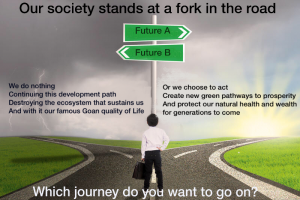The Green & Flourishing Future We All Want And need
THE NEED
What if the future of the world depended on tropical belt rural communities finding ways of developing 21st century lives and green economies not only in harmony with their local ecosystems but that also protect and nourish biodiversity, rather than destroy it, so that the world can breathe?
The role of the green cover in the tropical belt is critical in climate change and air quality. It is increasingly clear that Asia needs to urgently research and develop a new development model that supports the viability of rural ecosystem diversity and agriculture, whilst also limiting the development footprint of infrastructure improvements and increasing resilience.
Today’s dominant development model would see places like Goa lose its appealing village structure, culture, heritage and tropical landscape in favour of increasing urbanisation, deforestation and loss of biodiversity and agricultural health and wealth and village community. The identity of Goa needs to survive into a 21st century future.
Niti Aayog, the EU and GIZ have selected Goa as a pilot state for their “Resource Efficiency and Circular Economy” initiative. There is opportunity to leverage resources and technical support into Goa within a broader participatory Green Economic transition journey for Goa
THE ASPIRATION
What if the next generation of privilege was access to clean air, clean water, clean soil and food, greenery and biodiversity, as well as strong families and supportive communities of empowered men, women and children?
The dominant development model favours urbanisation which creates polluted, toxified air and water and requires chemical food chains and breaks down local ecosystems. It also challenges community and family structure; alienation and stress is causing mental health issues as people find themselves disconnected from themselves, each other and nature.
Meanwhile, migration to the cities across India is of great risk to Indian Well-being in terms of food insecurity and overpopulation. Increasingly, urban families who want mental and physical well-being and have the financial means, look to spend time outside of the cities. Goa is increasingly the destination of choice for Indian and international settlers who have suffered in the cities of the world and now highly value Goa’s natural green environment for the wellbeing and quality of life it provides them and their children. Clocking off and being and playing together on the beach or in the jungle together is so precious it is truly valuable.
Meanwhile, the journey of opportunity for most Goans is to leave the state or the country and find work elsewhere.
What if the next generation of privilege was access to clean air, clean water, clean soil and food, greenery and biodiversity, as well as strong families and supportive communities of empowered men, women and children?
WHAT IF WE ALREADY HAVE WHAT WE NEED FOR AN ASPIRATIONAL LIFE?
PRUDENT
What if the antidote to global radicalisation and violence was community participation in ways of talking and listening to each other that nurture peaceful co-existence, being seen and heard, belonging, and navigating conflict lightly and respectfully?
Modern western and Middle Eastern cities which appeared to present a model for replication and growth from the East show signs of instability as diversity, poverty and disempowerment increasingly create angry citizens who have lost faith in voting and look for other means of social participation and validation whether violently or virtually.
Finding ways of nurturing community cohesion and peaceful, respectful co-existence is urgent in these places. Asia needs to be thinking ahead about how to build on its own cultural heritage of peace and tolerance to grow a generation of engaged citizens who can lead a sustainable and peaceful world. This is the leadership model of the future.
TIMELY
What if what if the need of the hour is to R&D how a modern rural village community can thrive as a viable green and fair economy and inspire other similar experiments to challenge and change how the world views progress and quality of life?
The Sustainable Development Goals (SDGs) show us that we have a lot of work to do. We need to understand how this translates into improved well being and prosperity in rural Asia.
Supporting rural communities with participatory leadership and other skills to map and value existing talents and assets as opportunities for green enterprise, food security and resilience engages people in designing and co-creating their own green futures. The young have not been given the invaluable apprenticeship into how to live sustainably in their ecosystem. Intergenerational learning of precious local and traditional sustainability knowledge and wisdom can be shared and captured before it is lost.

